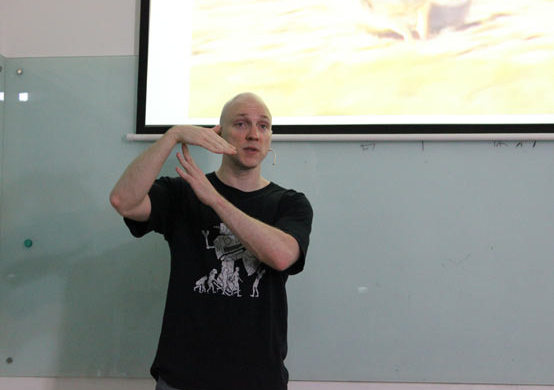

|
 Brian Dowrick began creating art when he was 5, drawing when he was in a bad mood and making flip-books with his mom's notebooks. |
Prompted by his work for the Beijing Olympics, US animator Brian Dowrick sets up a school in Beijing. Lin Jing follows the storyboard.
As the Beijing Olympics captured the attention of the world in 2008, Brian Dowrick was in China's capital working behind the scenes as an animation supervisor for the event. It was an exciting time and an insightful one for Dowrick, who through the experience realized the need for a quality animation school in China.
Two years later BaiAn 3-D Training Center was born with Dowrick as founder and instructor.
He wanted to train qualified animators to work for his animation studio Eclipse, but he also had grander plans for the school's role.
"In five to 10 years, I want the best animators in China to be students I have trained," he says.
Dowrick, from the US city of Philadelphia, has more than 20 years' experience in animation. He has worked on numerous films including Harry Potter and the Sorcerer's Stone and Night at the Museum.
Dowrick's first trip to China as an animator was in 2007, when he worked on the movie Red Cliff by director John Woo. Shortly afterward he began to divide his time between that and the Beijing Olympics, which he worked on for eight months.
"It was a lot of pressure, because you never knew what tomorrow would bring," he recalls. "The job and responsibility was also huge."
"It is one of those experiences, just like if you are knocked off a boat, which is not something you would choose to do, but after you have done it, you become a better person afterward."
The training center was set up with an investment of 300,000 yuan ($48,000) to cover rent, equipment and salaries.
Initially, Dowrick and his business partner Che Yanchun wrote up course material and conducted classes. Dowrick critiques the students' work and spends time at the center to ensure teaching quality. More than 30 students have graduated to date.
Na Heya, 22, a student who majored in animation, says she signed up for the course after viewing an interview with Dowrick online.
"The ideas and skills taught here are really useful and practical for my future work," she says. She took up the course for basic learners last year and hopes to work for Eclipse after graduation.
Besides fresh graduates, there are also many experienced animators looking to polish their skills. Zhao Yanlu, 28, from Shijiazhuang, Hebei province, has experience as an animator, but expects his training at the center to secure him a better job.
"I believe that I can go further with a period of study here," he says.
According to Dowrick most students receive offers before finishing their course. Training at the center is open to anybody who wants to be an animator, including those with no experience.
He is also a passionate and opinionated speaker on the subject of animation and has strong views on the direction of the industry in China.
"Animation levels in the West are so much higher than Chinese levels that there is no competition, and the only area in which China can compete is low price," he says. "The price for the same project will be eight to 10 times more in the West than in China."
Several major studios, including Disney and DreamWorks, are setting up studios in China, to take advantage of lower costs.
This will benefit Chinese animators by creating more job opportunities and making it easier for them to work with major US studios, according to Dowrick. However, it could also push up costs and lead to China losing its price edge in the industry.
Dowrick is critical of many Chinese animation schools, which he says only teach the basics.
"The expectations of the audience have gone up with the advancement of technology and they expect better animation, but the teaching levels of schools have remained the same," he says.
He adds Western animators have a different mentality than their Chinese counterparts.
"In the West, an animator will have to work for more than 10 years to become a supervisor, then work as a director, and then start their own studio. But in China, some will start their own studio right after six months of work. The time frame is much shorter, and the expectation of a fast return is higher in China," he says.
Dowrick began creating art and animation when he was 5 years old, drawing when he was in a bad mood, and often making flip-books using his mother's notebooks to create a moving image. When he applied for university, he chose to go where his interest lay - in animation.
"There are very few people out there in the world that would say that they love doing what they are paid to do," he says. "And to be among that unique small group, is a privilege. I would not want to trade it."
Contact the writer at linjingcd@chinadaily.com.cn.